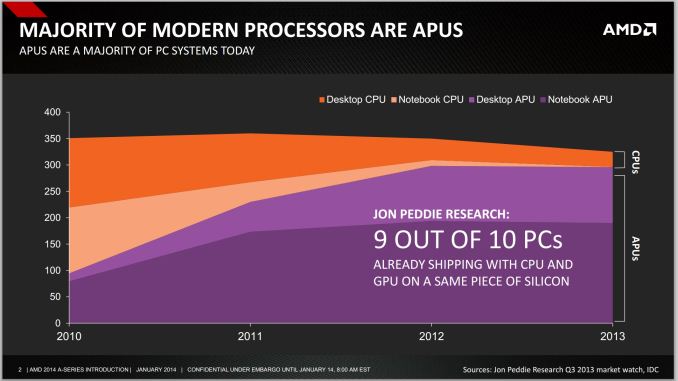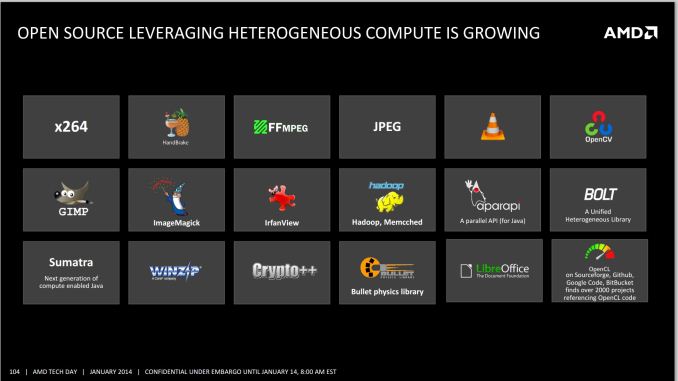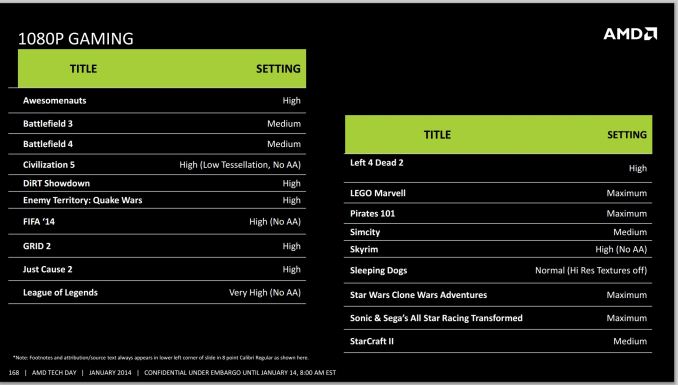AMD Kaveri Review: A8-7600 and A10-7850K Tested
by Ian Cutress & Rahul Garg on January 14, 2014 8:00 AM ESTKaveri: Aiming for 1080p30 and Compute
The numerical differences between Kaveri and Richland are easy enough to rattle off – later in the review we will be discussing these in depth – but at a high level AMD is aiming for a middle ground between the desktop model (CPU + discrete graphics) and Apple’s Mac Pro dream (offloading compute onto different discrete graphics cards) by doing the dream on a single processor. At AMD’s Kaveri tech day the following graph was thrown in front of journalists worldwide:
With Intel now on board, processor graphics is a big deal. You can argue whether or not AMD should continue to use the acronym APU instead of SoC, but the fact remains that it's tough to buy a CPU without an integrated GPU.
In the absence of vertical integration, software optimization always trails hardware availability. If you look at 2011 as the crossover year when APUs/SoCs took over the market, it's not much of a surprise that we haven't seen aggressive moves by software developers to truly leverage GPU compute. Part of the problem has been programming model, which AMD hopes to address with Kaveri and HSA. Kaveri enables a full heterogeneous unified memory architecture (hUMA), such that the integrated graphics topology can access the full breadth of memory that the CPU can, putting a 32GB enabled compute device into the hands of developers.
One of the complexities of compute is also time: getting the CPU and GPU to communicate to each other without HSA and hUMA requires an amount of overhead that is not trivial. For compute, this comes in the form of allowing the CPU and GPU to work on the same data set at the same time, effectively opening up all the compute to the same task without asynchronous calls to memory copies and expensive memory checks for coherency.
The issue AMD has with their HSA ecosystem is the need for developers to jump on board. The analogy oft cited is that on Day 1, iOS had very few apps, yet today has millions. Perhaps a small equivocation fallacy comes in here – Apple is able to manage their OS and system in its entirety, whereas AMD has to compete in the same space as non-HSA enabled products and lacks the control. Nevertheless, AMD is attempting to integrate programming tools for HSA (and OpenCL 2.0) as seamlessly as possible to all modern platforms via a HSA Instruction Layer (HSAIL). The goal is for programming languages like Java, C++ and C++ AMP, as well as common acceleration API libraries and toolkits to provide these features at little or no coding cost. This is something our resident compute guru Rahul will be looking at in further detail later on in the review.
On the gaming side, 30 FPS has been a goal for AMD’s integrated graphics solutions for a couple of generations now.
Arguably we could say that any game should be able to do 30 FPS if we turn down the settings far enough, but AMD has put at least one restriction on that: resolution. 1080p is a lofty goal to hold at 30 FPS with some of the more challenging titles of today. In our testing in this review, it was clear that users had a choice – start with a high resolution and turn the settings down, or keep the settings on medium-high and adjust the resolution. Games like BF4 and Crysis 3 are going to tax any graphics card, especially when additional DirectX 11 features come in to play (ambient occlusion, depth of field, global illumination, and bilateral filtering are some that AMD mention).













380 Comments
View All Comments
nader_21007 - Saturday, January 18, 2014 - link
Can you show me what improvement haswell did over previous gen? TDP going from 77W to 84W, meanwhile performance droped in most cases. Can't you see the charts in this review?Principle - Tuesday, January 14, 2014 - link
Andrew, that depends based on size, budget, etc...and I own an AMD Piledriver CPU and could never tell you when it was supposedly slower, maybe a game takes a couple seconds longer to load, but after that its all the same.And I have used Intel CPUs too, and have hiccups and lag multitasking with them in real life, that never happens on my AMD systems. If you get an i5 and an AMD GPU, that would be great and last with the GPU compute advantage of AMD GPUs and the Mantle potential.
These Kaveri have a lot of value at launch for the entertainment center PCs, or ITX platforms because at 65W or even 45W it delivers a lot of performance in one chip that you can keep cool and quiet in a small package. Also good for all in one PCs built into the monitor. Not for the avid gamer right now, but a little more future proof than an Intel CPU in my opinion.
ImSpartacus - Thursday, January 16, 2014 - link
If you're not gaming, is it really that hard to "future-proof" your CPU?I feel like most low end CPUs will perform "basic" non-gaming tasks for many years to come.
andrewaggb - Tuesday, January 14, 2014 - link
To be clear, I'd get an i5 quad core with a 260x or 270x. I realize they aren't at all in the same price range, but it's good performance per dollar.I was expecting Kavari to have 10% better cpu performance and 25% better gpu performance. This has equal cpu performance and essentially equal gpu performance. It has other improvements, but that's a serious dissappointment on the performance side of things.
I've already got 3 i5 quad cores with a 6870, 7850, and 270x in each and I'm happy with them. Just though Kaveri might be good enough, and it is for older stuff and minecraft and whatnot.
But it seems like yet another year that paying the extra money and having some longevity is going to be the right move.
Quite frankly my oldest system, the i5 750 with a 6870 would mop the floor with kaveri in everything but power consumption.
yankeeDDL - Wednesday, January 15, 2014 - link
You're kidding right?It practically doubled the performance per watt of Richland (45W Kaveri almost always outpaces 100W Richland) and that's disappointing?
It's true that Richland was way behind, but the improvement is massive.
There's still a glaring gap with Intel's CPU, but it is smaller.
Just as much as the glaring gap on the GPU side (but this time on AMD's favor) got wider.
HSA is the key for AMD to push the GPU advantage over to the CPU to compensate. If it works, then Kaveri will be really up to, or better of the core I5 which cost more than 2X ... "IF" ...
Jaybus - Thursday, January 16, 2014 - link
I'm not convinced HSA is the future. It is a diminishing returns issue. The only difference between HSA and SMP is different types of cores are being used. The bus arbitration and coherency issues are exactly the same. Neither is scalable to dozens of cores, let alone hundreds. HSA has the same limitations as SMP. Something like Knights Corner's ring bus and message passing is more likely the future. Near term, there is an advantage to HSA. Long term will rely on a much faster chip-to-chip interconnect to transfers and segmented memory to avoid the arbitration and coherency issues. CMOS silicon photonics maybe. That would enable optical busses orders of magnitude faster than PCIe, or in fact much faster than any chip-to-chip electronic bus, and that would make something like Knights Corner's ring bus the future path to high core counts.jimjamjamie - Thursday, January 16, 2014 - link
A genuinely interesting and insightful comment, thanks.artk2219 - Tuesday, January 14, 2014 - link
Until you play a game that uses more than 2 threads, or have tasks running in the background while gaming, then you'll wish you had those two extra threads. Seriously I wish people would quite trying to recommend dual cores for gaming or even general use, unless its in a machine for the type of person that only does one or two things thing at a time. Dual cores are showing their age now, its only going to be worse a year or two from now. Also why would you spend 90 on a Pentium dual core when you could spend 80 on an Athlon 750k or that same 90 on a 760k. They have similar single thread performance and stomp the g2120 in multithreaded situations, plus they're unlocked so you can overclock to your hearts content. Im not saying that Kaveri isn't overpriced right now, they could stand to drop 20 dollars for the top two chips and 10 for the last chip reviewed. But they just launched and those prices will change, and in the end its easier to point people to one part for all of their needs than it is to point them to two.http://www.newegg.com/Product/ProductList.aspx?Sub...
Nagorak - Wednesday, January 15, 2014 - link
The Intel processors are more energy efficient. That's one reason.artk2219 - Wednesday, January 15, 2014 - link
Fair enough, but its a negligible difference once you factor in the discrete GPU that you would be pairing it with anyways. Cooling it shouldn't be anymore of a problem than cooling the same setup with the DGPU, granted there aren't really any fm2+ itx boards so that may be a problem if you're going for a tiny size, but thats about it.